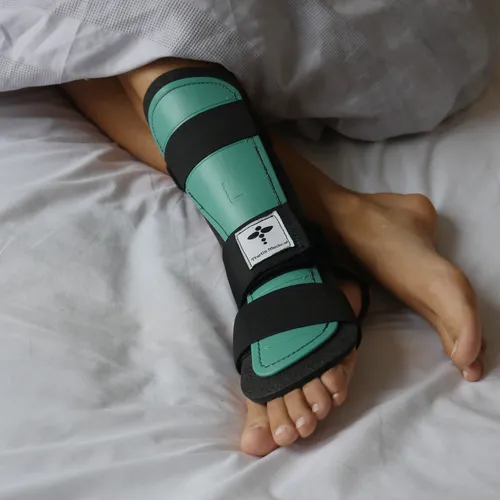Life After Achilles Rupture: Recovery Tips, Walking Timeline & Activity Guide
Get the full eBook on Achilles tendon ruptures FREE.

Torn Achilles? Sleep Soundly with the Splint.
The Splint is designed for comfort and to protect your healing Achilles.
Buy NowFrequently Asked Questions (FAQs)
When can I walk after an Achilles rupture?
You can and should walk once you are supported in a suitable boot that holds your foot in a tip-toe posture. Crutches are only needed for balance. Walking on the injured leg while wearing the boot is beneficial for healing, as it helps the tendon ends join efficiently and strongly. Wearing a shoe with a generous heel on your uninjured foot helps keep you level. This early walking approach has resulted in fewer re-ruptures compared to older treatments that required months of plaster casts and one-legged hopping.
How long does recovery from Achilles rupture take?
Full recovery from an Achilles rupture typically takes about a year. You'll need to wear a boot or similar support for approximately 10 weeks. After this, it takes several months to regain muscle strength, with most people experiencing activity limitations for at least 6 months. Even long-term, the calf muscle on the injured side may remain slightly smaller but will be strong enough for normal function. The healed tendon will be thicker initially but improves over months to years.
When can I return to sports and physical work?
Most rehabilitation programs allow return to sports and physical work after 6 months. However, the exact timing depends on the specific sport or type of work involved. Full recovery typically takes about a year.
How can I prevent re-rupturing my Achilles?
To prevent re-rupture, it's crucial to wear the boot as instructed for the full 10 weeks without taking shortcuts. When removing the boot (e.g., for washing), always be seated first and maintain the tip-toe posture. Don't bend the ankle up to reach your toes. If you're not flexible enough, get help rather than risk injury. Even a small slip can cause a re-rupture and force you to restart the entire recovery process.
What are the long-term effects of an Achilles rupture?
While Achilles ruptures generally heal well with proper treatment, there are some long-term changes. The calf muscle on the injured side typically remains slightly smaller than before, though it maintains normal function. The healed tendon stays somewhat thicker than the original, though this thickness gradually improves over months to years. Despite these changes, most people return to normal activities.